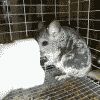All photos of Higgins are copyrighted ( © 1999-2007 ) by The Chinster





| Chin Fur Chewing |
Chin Fur Chewing
|
Description |
|
Fur chewing is a behavioural disorder among Chins. While the potential causes may be varied and indeterminant [see next section, "Causes"] , its appearance is fairly consistent among afflicted individuals. The chewed fur areas are typically located about the haunches, legs, and, in many cases, the tail. The fur itself will be very short as the bar, if any, and fur tips will be cropped. Among Standard Greys and Black Velvets, the slate grey underfur will be exposed. With other colours such as Wilson White and Tower Beige, a dramatic colour change will not be evident as the entire fur strand is already coloured white and beige, respectively.
Fur chewing cannot be confused with other fur ailments such as Fur Fungus [aka Ringworm] or metabolic/nutritional disorders as there will be no bald patches. In contrast, Fur Fungus will be characterized by bald patches with red dots or areas on the skin itself and often begins about the side of the face. Baldness due to metabolic/nutritional disorders will look similar to fur fungus except that the skin will have normal pigmentation, it typically begins at the rump, and the Chin will be severely underweight.
Here are some examples of severe fur chewers [click on each thumbnail image below for a fullsize image which will open up in a popup window] :
Higgins
(September, 2001)
[Courtesy of
The Chinster
]
All photos of
Higgins
are copyrighted (
© 1999-2007
) by
The Chinster





Ame
from
Dakota County Technical College [DCTC], Minnesota, USA
(September, 2002)
[Courtesy of
Emily
]
All photos of
Ame
are copyrighted (
© 2002-2003
) by
Emily






Coolio
(September, 2002)
[Courtesy of
Alison
]
All photos of
Coolio
are copyrighted (
© 2002-2003
) by
Alison



Quoia
of
Chin Colores
(October, 2002)
[Courtesy of
Pamela
]
All photos of
Quoia
are copyrighted (
© 2002-2003
) by
Pamela



Quoia, a Black Velvet, is a particularly striking example because he shows a dramatic colour change on the dorsal surface from the normal jet black of the fur tips to the slate grey of the underfur.
|
Causes |
|
|
1. Genetic Predisposition |
|
|
2. Behavioural Reactions |
|
These behaviours can be learned via observation and imitation [ie., from cagemates or neighbours] OR develop in isolation. Any apparent genetic component would seem to reside in a particular animal's ability to cope with stress rather than in any specific behaviour pattern.
|
3. Cage Mate |
|
|
4. Nutritional Deficiency |
|
|
Treatments |
|
|
1. Behavioural/Environmental Remediation |
|
a) environmental enrichment: provision of toys, variety of substrates [bedding material]
b) behavioural stimulants: extra interaction with humans, a Chin companion, treats, extra romp time
c) behavioural training [ie., using classical and/or operant conditioning techniques].
|
2. Stress Alleviation |
|
Fur-chewing due to genetic predisposition is not normally cureable but triggers such as stress, etc can be minimized. The maintenance of a stable environment would fall into this situation.
|
3. Medication |
|
Persistent fur-chewing may lead to the development of furballs in the Chin's digestive system. ChinLady chinlady2000@aol.com suggests that one can use Laxatone or Laxaire to prevent intestinal fur blockages. Since Chins love the taste of it, you can simply put it on their paws or just let them lick the stuff off your fingers or a tongue depressor. Others provide regular doses of papaya enzyme for the same purpose.
|
4. Proper Diet |
|
Created by ChinMania
© 1999-2007 ChinMania & AniMania The concept, design, and all content of ChinMania, the Chin Colour Calculator, the Chin Colour Crosses, the Chin Owners Directory, as well as the terms "ChinMania", "Chinmania", "chinmania", "Chin Mania", "Chin mania", "chin mania", "ChinManiac", "Chinmaniac", "chinmaniac", "Chin Maniac", "Chin maniac", "chin maniac", and any derivations thereof, is copyrighted by ChinMania and AniMania ( © 1999-2007 ChinMania & AniMania ) and may not be used without the express written permission of ChinMania and AniMania.
All photos on this page are copyrighted ( © 1999-2007 ) by the respective contributors and are used here with their express permission.
